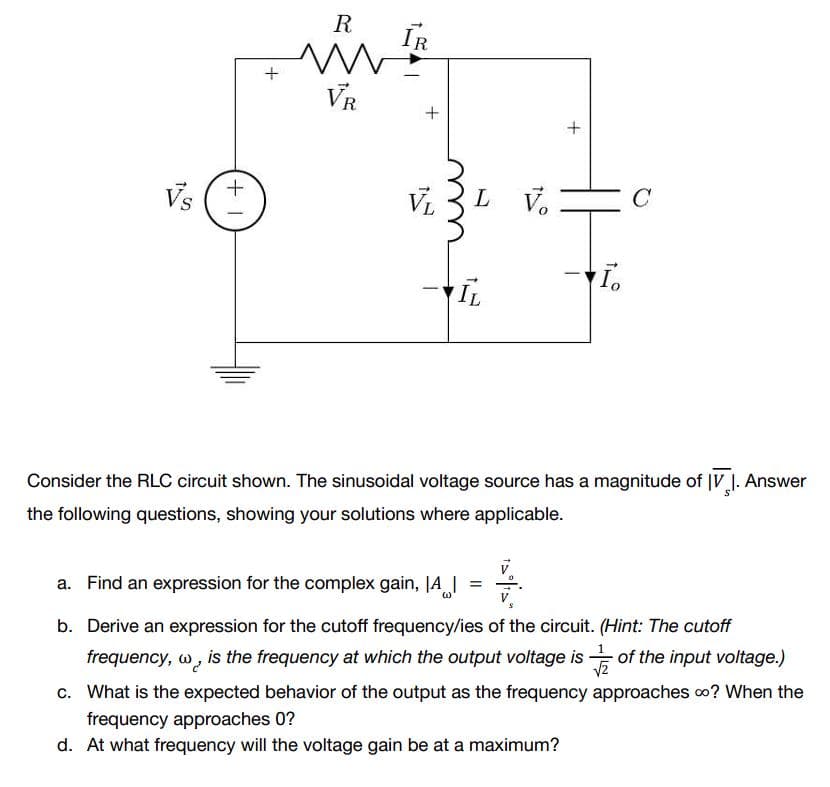+1 + R VR ĪR + + L V Vs I. IL Consider the RLC circuit shown. The sinusoidal voltage source has a magnitude of IV 1. Answer the following questions, showing your solutions where applicable. a. Find an expression for the complex gain, |A| (1) b. Derive an expression for the cutoff frequency/ies of the circuit. (Hint: The cutoff frequency, w, is the frequency at which the output voltage is of the input voltage.) √2 c. What is the expected behavior of the output as the frequency approaches ∞? When the frequency approaches 0? d. At what frequency will the voltage gain be at a maximum? C
+1 + R VR ĪR + + L V Vs I. IL Consider the RLC circuit shown. The sinusoidal voltage source has a magnitude of IV 1. Answer the following questions, showing your solutions where applicable. a. Find an expression for the complex gain, |A| (1) b. Derive an expression for the cutoff frequency/ies of the circuit. (Hint: The cutoff frequency, w, is the frequency at which the output voltage is of the input voltage.) √2 c. What is the expected behavior of the output as the frequency approaches ∞? When the frequency approaches 0? d. At what frequency will the voltage gain be at a maximum? C
Introductory Circuit Analysis (13th Edition)
13th Edition
ISBN:9780133923605
Author:Robert L. Boylestad
Publisher:Robert L. Boylestad
Chapter1: Introduction
Section: Chapter Questions
Problem 1P: Visit your local library (at school or home) and describe the extent to which it provides literature...
Related questions
Question

Transcribed Image Text:+1
+
R ĪR
VR
+
+
Vs
I.
IL
Consider the RLC circuit shown. The sinusoidal voltage source has a magnitude of IV 1. Answer
the following questions, showing your solutions where applicable.
a. Find an expression for the complex gain, |A|
(1)
b. Derive an expression for the cutoff frequency/ies of the circuit. (Hint: The cutoff
frequency, w, is the frequency at which the output voltage is of the input voltage.)
√2
c. What is the expected behavior of the output as the frequency approaches ∞? When the
frequency approaches 0?
d. At what frequency will the voltage gain be at a maximum?
L V
C
Expert Solution
This question has been solved!
Explore an expertly crafted, step-by-step solution for a thorough understanding of key concepts.
This is a popular solution!
Trending now
This is a popular solution!
Step by step
Solved in 6 steps with 6 images

Knowledge Booster
Learn more about
Need a deep-dive on the concept behind this application? Look no further. Learn more about this topic, electrical-engineering and related others by exploring similar questions and additional content below.Recommended textbooks for you

Introductory Circuit Analysis (13th Edition)
Electrical Engineering
ISBN:
9780133923605
Author:
Robert L. Boylestad
Publisher:
PEARSON

Delmar's Standard Textbook Of Electricity
Electrical Engineering
ISBN:
9781337900348
Author:
Stephen L. Herman
Publisher:
Cengage Learning

Programmable Logic Controllers
Electrical Engineering
ISBN:
9780073373843
Author:
Frank D. Petruzella
Publisher:
McGraw-Hill Education

Introductory Circuit Analysis (13th Edition)
Electrical Engineering
ISBN:
9780133923605
Author:
Robert L. Boylestad
Publisher:
PEARSON

Delmar's Standard Textbook Of Electricity
Electrical Engineering
ISBN:
9781337900348
Author:
Stephen L. Herman
Publisher:
Cengage Learning

Programmable Logic Controllers
Electrical Engineering
ISBN:
9780073373843
Author:
Frank D. Petruzella
Publisher:
McGraw-Hill Education

Fundamentals of Electric Circuits
Electrical Engineering
ISBN:
9780078028229
Author:
Charles K Alexander, Matthew Sadiku
Publisher:
McGraw-Hill Education

Electric Circuits. (11th Edition)
Electrical Engineering
ISBN:
9780134746968
Author:
James W. Nilsson, Susan Riedel
Publisher:
PEARSON

Engineering Electromagnetics
Electrical Engineering
ISBN:
9780078028151
Author:
Hayt, William H. (william Hart), Jr, BUCK, John A.
Publisher:
Mcgraw-hill Education,